
Tragedy in the Skies: The 2010 Alaska USAF C-17 Crash and Its Lasting Impact
On July 28, 2010, a United States Air Force C-17 Globemaster III crashed at Joint Base Elmendorf-Richardson in Alaska, killing all four crew members aboard. The accident, which occurred during a training exercise, was a devastating reminder of the risks faced by military personnel in their service to the nation. Investigators later determined that the crash resulted from pilot error, raising important questions about flight safety, training procedures, and risk management in military aviation.
The Mission and Crew
The ill-fated aircraft, designated as “Sitka 43,” was assigned to the 3rd Wing at Joint Base Elmendorf-Richardson. On the evening of July 28, the crew was conducting a practice flight for an upcoming airshow demonstration. The training exercise was meant to simulate an aerial performance for the Arctic Thunder Air Show, an annual event showcasing military aviation capabilities.
The four crew members onboard were experienced Air Force personnel:
• Pilot: Maj. Michael Freyholtz
• Co-Pilot: Maj. Aaron Malone
• Safety Observer: Lt. Col. Paul Stombaugh
• Loadmaster: MSgt. Thomas Cicardo
Each member had extensive flight experience, making the tragedy even more shocking to the Air Force community.

The Final Flight and Crash
The C-17 took off at 6:22 p.m. local time under clear skies. Shortly after departure, the aircraft began maneuvering aggressively in preparation for its airshow routine. Witnesses on the ground, including other military personnel, noticed the aircraft executing steep turns and sharp climbs—an uncommon sight for a large transport aircraft like the C-17.
Approximately 40 seconds before impact, the aircraft entered a dangerously steep climb, followed by a stall warning. The crew struggled to recover, but the plane rapidly lost altitude. At 6:27 p.m., the massive transport aircraft crashed into a wooded area near the base, erupting into flames. The impact destroyed the aircraft, leaving no survivors.
Investigation Findings: Pilot Error
In the aftermath of the crash, the United States Air Force launched a thorough investigation to determine what went wrong. The official report, released in December 2010, concluded that pilot error was the primary cause of the accident.
The findings indicated that the pilot, Maj. Freyholtz, had exceeded the aircraft’s operational limits by performing excessively aggressive maneuvers. Specifically, he had banked the aircraft at a dangerously high angle and failed to maintain sufficient airspeed. This resulted in an aerodynamic stall—a condition in which an aircraft loses lift and can no longer sustain flight.

The investigation also revealed that previous training flights for the airshow demonstration had involved similarly aggressive maneuvers, increasing the likelihood of a mishap. The report noted that while the C-17 is a highly capable transport aircraft, it was not designed for extreme aerial acrobatics.
Lessons Learned and Safety Changes
The crash of Sitka 43 prompted the Air Force to review and reinforce its flight safety protocols, particularly for demonstration flights. Key changes included:
1. Stricter Airshow Flight Guidelines – The Air Force implemented stricter regulations on how transport aircraft like the C-17 should be flown during airshow demonstrations. Maneuvers deemed too risky were prohibited.
2. Enhanced Training for Stall Recovery – Additional emphasis was placed on stall recognition and recovery procedures in training programs, ensuring that pilots were better prepared to handle similar emergencies.
3. Flight Risk Assessments – The Air Force increased the frequency and thoroughness of risk assessments before training and demonstration flights, requiring closer scrutiny of planned maneuvers.
While these changes could not undo the loss of four highly skilled crew members, they were crucial in preventing similar accidents in the future.
Remembering the Fallen
The loss of Maj. Freyholtz, Maj. Malone, Lt. Col. Stombaugh, and MSgt. Cicardo was deeply felt within the military aviation community. Memorial services were held to honor their service and sacrifice, and their names were added to the list of those who had given their lives in the line of duty.
The crash site was carefully examined during the investigation, and debris was removed in a manner that respected the memory of those lost. Today, the fallen crew members are remembered as dedicated servicemen who contributed to their country’s defense and military excellence.
The C-17 Globemaster III: A Workhorse of the Air Force
Despite the tragic crash, the C-17 remains one of the most vital aircraft in the U.S. Air Force fleet. Known for its versatility, the Globemaster III is capable of transporting troops, cargo, and even vehicles across vast distances. It has played a crucial role in humanitarian missions, combat operations, and emergency evacuations worldwide.
The Alaska crash did not reflect a flaw in the C-17’s design but rather the risks involved in pushing an aircraft beyond its intended operational envelope. The aircraft continues to serve as a reliable transport platform, with modifications and safety enhancements ensuring its continued success.

Conclusion
The 2010 Alaska USAF C-17 crash was a heartbreaking loss that underscored the importance of safety, training, and risk management in military aviation. While the investigation determined that pilot error was the primary cause, it also served as a learning experience that led to critical safety improvements.
The four crew members who lost their lives that day remain honored within the Air Force community. Their sacrifice serves as a reminder of the dedication and bravery of those who serve, as well as the constant need for vigilance in ensuring that military operations remain as safe as possible.
As we look back on this tragedy, we recognize not only the lives lost but also the lessons gained—lessons that continue to protect military personnel and ensure the highest standards of aviation safety.


